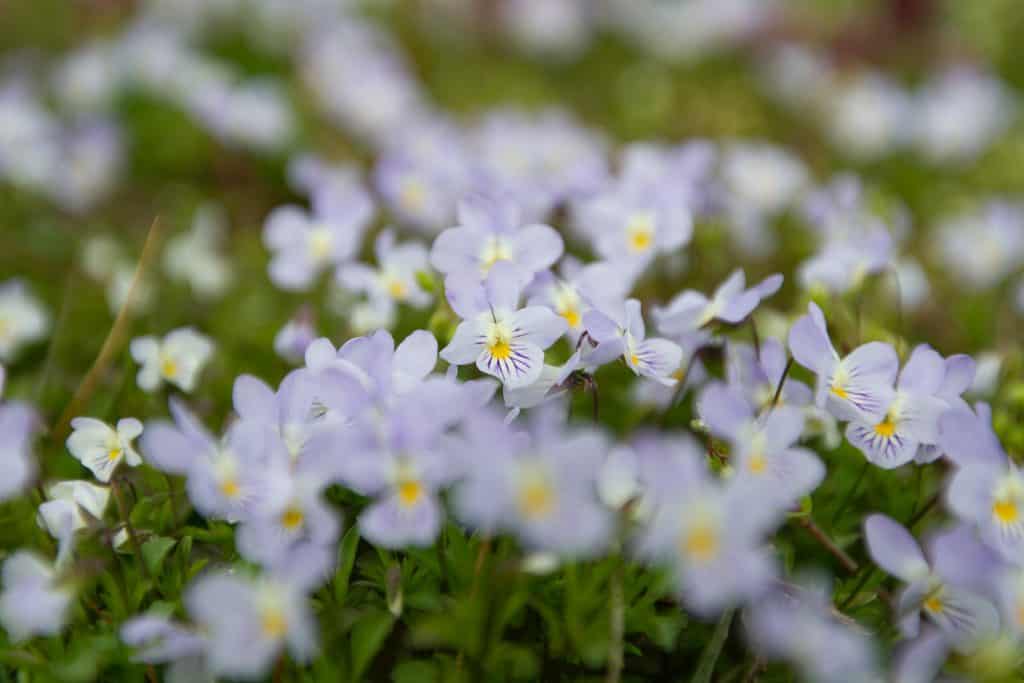One of the most helpful general rules of landscaping is that if you plant enough desirable plants, there won’t be room for the undesirable plants to grow. Using beautiful plants to choke out the unwanted weeds in your gardens is a great way to avoid hours of weed pulling and harmful chemical applications.
Vigorously growing groundcover plants are great for choking out weeds. They will add beauty to your outdoor space while being low-maintenance and beneficial in preventing weeds. Some of these ground covers are edible too, which is always nice for your cooking needs!
If you have a spot in your landscape with a weed problem, consider getting these low-growing, usually mat-forming plants. All of these plants have one thing in common; they grow densely enough to help prevent weed growth. Another plus is that these plants can often survive in places where other plants can’t. Using hardy ground covers for weed control might just be the best (and one of the easiest) things that you can do for your yard.
Be aware that vigorous growth and the ability to thrive in many varied environments will often cause a plant to be labelled as invasive, so use these plants carefully in your garden and pay attention to their growth habits so that they don’t overtake areas with more delicate plants.
Table of Contents
Here is a list of plants that work great for choking out weeds
Lily of the Valley (Convallaria majalis)
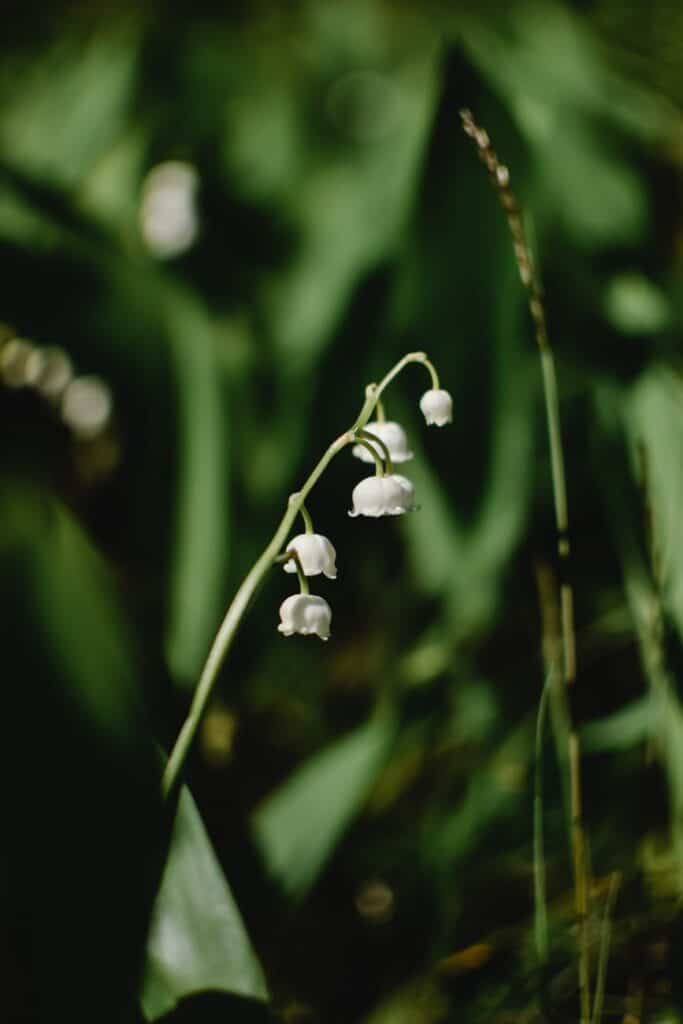
Lily of the Valley is usually planted in gardens because of its fragrant flowers and ability to cover the ground in shady places. The Royal Horticultural Society has given it the Award of Garden Merit.
Lily of the Valley serves as a weed-suppressant and a beautiful sight with adorable white bells hanging from long green stems. This delicately scented perennial spreads quickly, so keep it in check by planting it in well maintained areas such as along walkways and in bordered beds. It likes to be in the shade, although it can tolerate some sunlight.
If humans or animals eat Convallaria majalis, it’s extremely poisonous, due to the high concentration of cardiac glycosides (cardenolides).
Many gardeners would criticize and worry about this plant, claiming that it is invasive. This is correct in a poor location, but it is especially useful in places where nothing else can grow.
Creeping Phlox (Phlox Subulata)
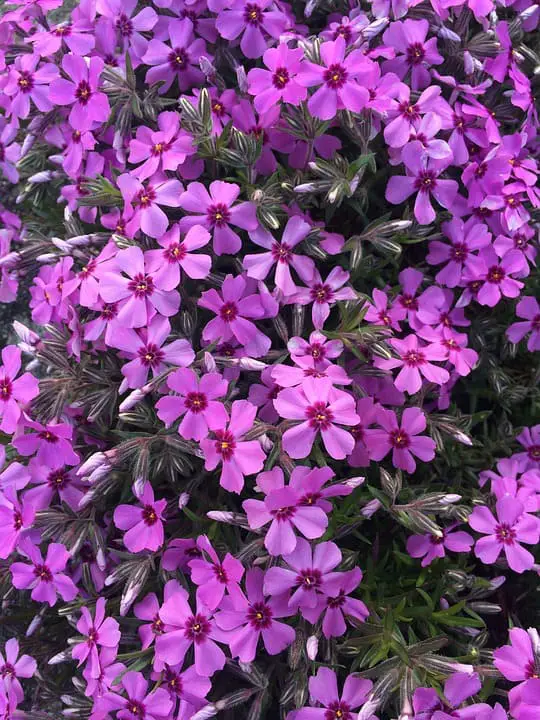
Carpets of Creeping Phlox in your yard can suppress weeds, especially on slopes that are difficult to mow. This plant is a resilient, reliable groundcover plant that’s common in rock gardens. Many phlox species and cultivars have a mild sweet smell.
These plants are cultivated for their prolific flowering; thus, if you have Phlox in your garden, butterflies will be present there too.
Some species are shrouded in flowers when in bloom, making it difficult to see any leaves. Almost all cultivars and wild species flower in the cool color spectrum, which includes white, purple, pink, magenta, blue, and purple.
Since creeping Phlox is evergreen, it’s suitable for thick groundcover or adorning stones and walls. While Phlox prefers damp, well-drained soils, it can adapt pretty well.
Tufted Creeping Phlox (Phlox Stolonifera)
Phlox Stolonifera thrives in moist, shady environments, where it successfully suppresses weed invasion.
This North American-native herbaceous perennial produces tiny pale pink or white flowers in the spring and has evergreen needle-like leaves. They don’t have the central band of color that the related Phlox subulata flowers have. Stolons or rooting runners are the reason for the specific epithet.
This groundcover is ideal for a shade garden, for use as butterfly nectar plants, or as part of a mass planting or grouping. Partially shaded woodlands or gardens with moist, well-drained soil will be the best for Phlox stolonifera. Its showy blooms make Phlox stolonifera a good option for cottage gardens, rock gardens, and low-maintenance plantings.
Creeping Juniper (Juniperus horizontalis)
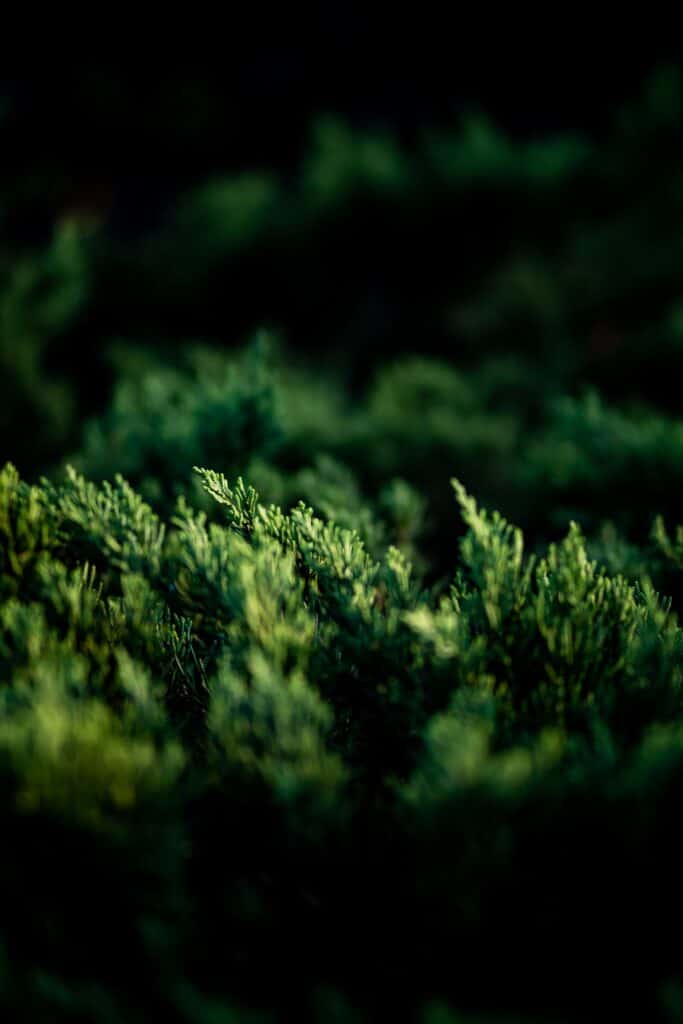
The combination of Creeping junipers’ horizontally spreading roots and their dense growth form a thick mat that can keep weeds from getting through.
Creeping juniper is a slow-growing plant. It likes direct sunlight, tolerates drought, and can live in poor, dry soil. It adapts pretty well, so you can take advantage of it by planting in places you don’t have time to maintain! For instance, this plant is suitable for xeriscaping.
Creeping junipers are also useful for preventing soil erosion on slopes and hillsides. Creeping Juniper’s growth rate and plant size is linked to climate and site conditions. Without adequate sunlight, the foliage will be thin and wont do a very good job of limiting the weed growth.
Greek Yarrow (Achillea ageratifolia)
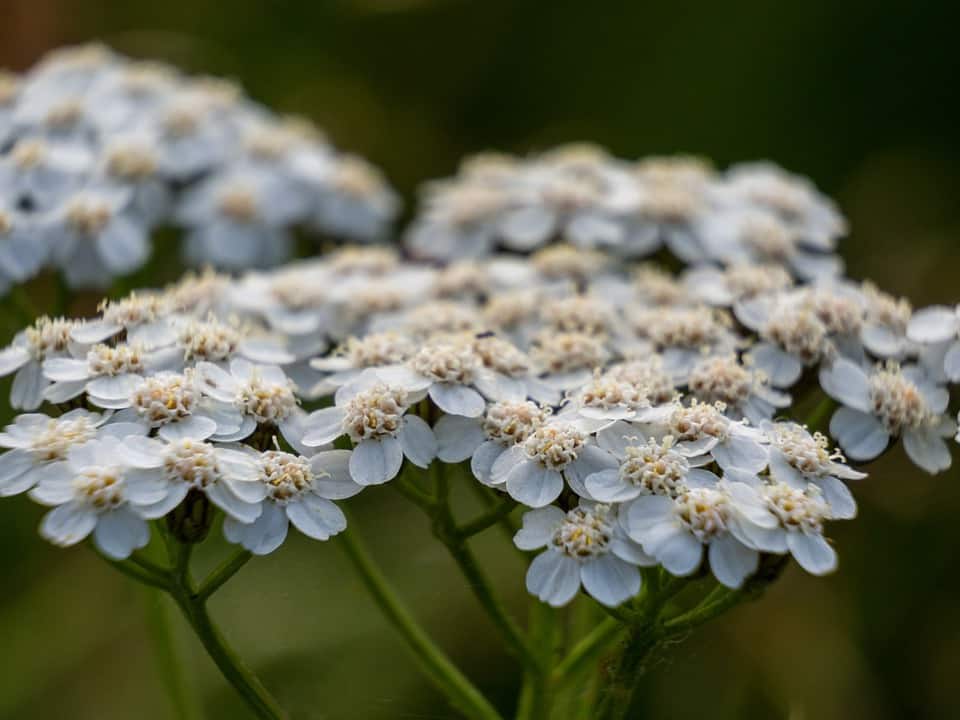
Greek Yarrow’s genus name, “Achillea,” originates from Achilles, the Greek war hero during the Trojan War who is said to have found it and used it to stop the flow of blood from his soldiers’ wounds.
The silvery, silky-textured foliage of Greek Yarrow forms a thick carpet that makes a tight groundcover. It’s a fantastic little evergreen weed suppressor (or, in this case, ever-grey). Over a blanket of silvery leaves, this tough groundcover grows pure white button daisy flowers that would look great with other flowers in your garden!
Greek yarrow blooms in the spring and produces buttons all summer and into the fall. This hardy little groundcover comes from the rough mountains of northern Greece, which are dry and hot. Once it’s established, it has great heat and drought tolerance. It can also live in low-quality, sandy, or rocky soils, which is where it thrives. It is also a perfect fit for windy gardens, especially near the beach!
Silver Mound (Artemisia schmidtiana)
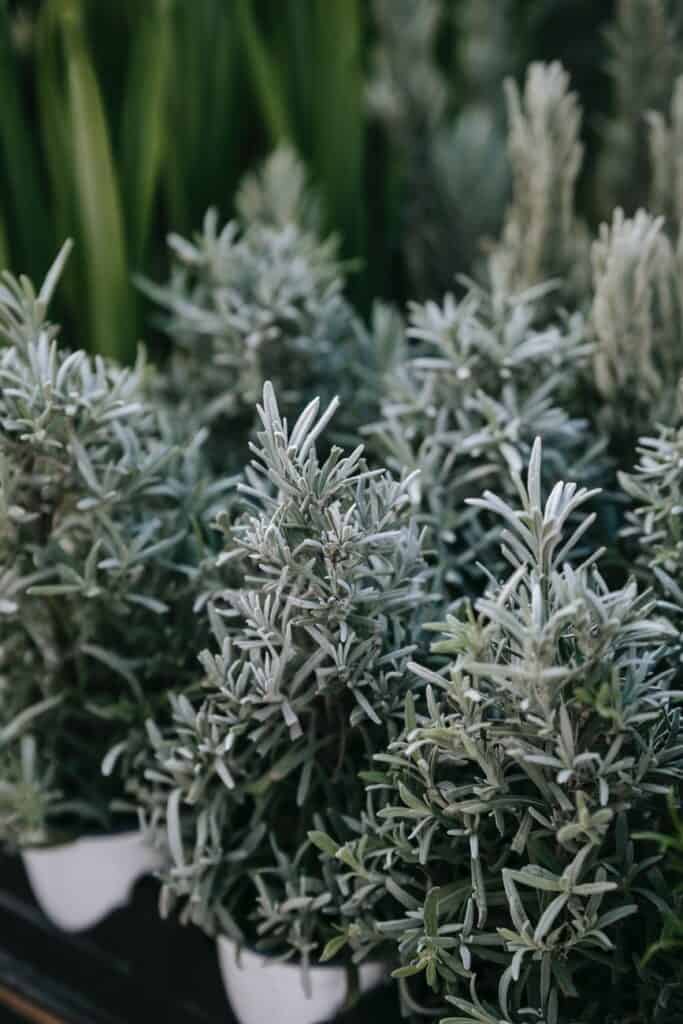
The beautiful Artemisia schmidtiana is suitable as a stretching border for the flower bed, especially if you place it around your pathways or your perennial garden. Its beautiful, hairy silvery leaves stand out by making a nice contrast to all your vibrant green plants.
You will like that even in the hottest summers, the silky, sensitive foliage maintains its fine form and color. Who doesn’t want a drought-resistant plant that thrives in both dry and moist soil?
This particular plant species, also known as silver mound wormwood, is a small one. When distributed among big, thriving summer blooms, it acts as a hardy ground cover (grows only up to 14 inches), blocking out weeds which is always a good thing. Plus, its deer and rabbit resistance mean it’s a valuable mat-forming plant to have in your landscape.
Creeping Thyme (Thermus serpyllum)
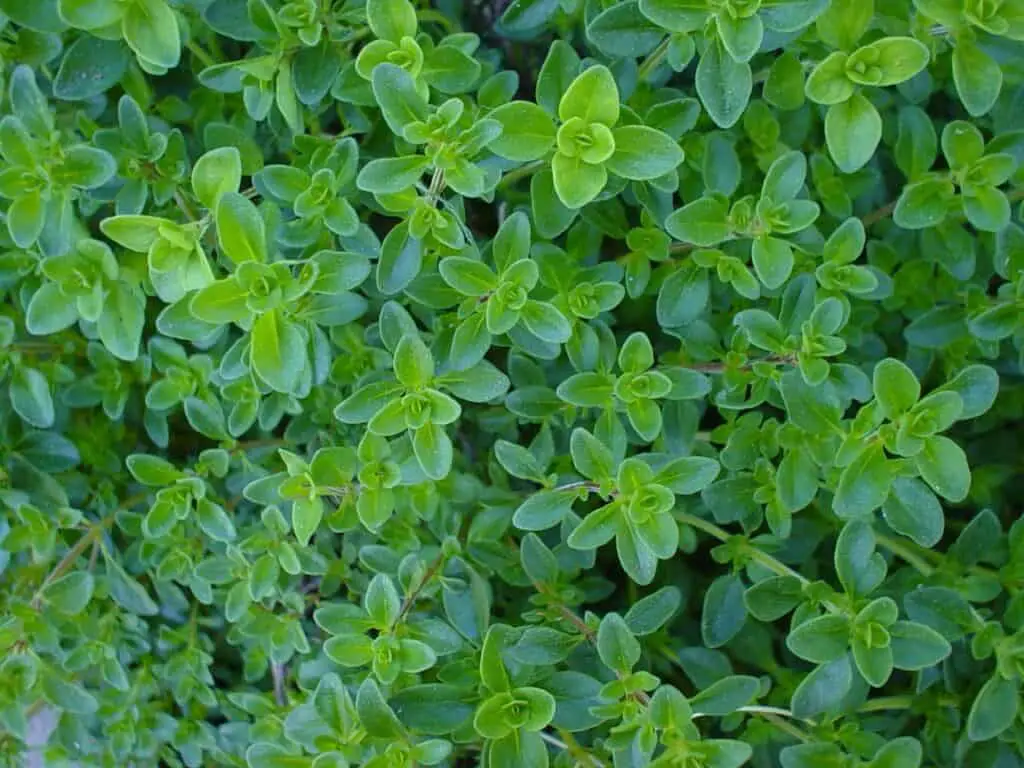
Aside from adding beauty to your landscape, Creeping Thyme forms a dense mat that chokes out weeds quite effectively. In late spring, Creeping Thyme’s short mats get shrouded in tiny white or purple flowers, making it a pollinator’s paradise.
This hardy perennial spreads quickly, is cold-hardy, flourishes in full sun can grow even in poor quality soil, and, once established, is drought resistant. You can also cut some leaves to use for your food prep!
When crushed or extracted for teas or tinctures, creeping thyme, like other thyme varieties, has a taste and fragrance similar to mint. It is a species of the mint family Lamiaceae, after all.
An even more interesting thing about creeping thyme is that considering its appealing scent, it is deer resistant, rendering it an excellent landscape choice in places with lots of deer. Creeping thyme can also tolerate being tromped on, making it a great option for planting in areas with a lot of foot traffic.
Dead Nettle (Lamium purpureum)
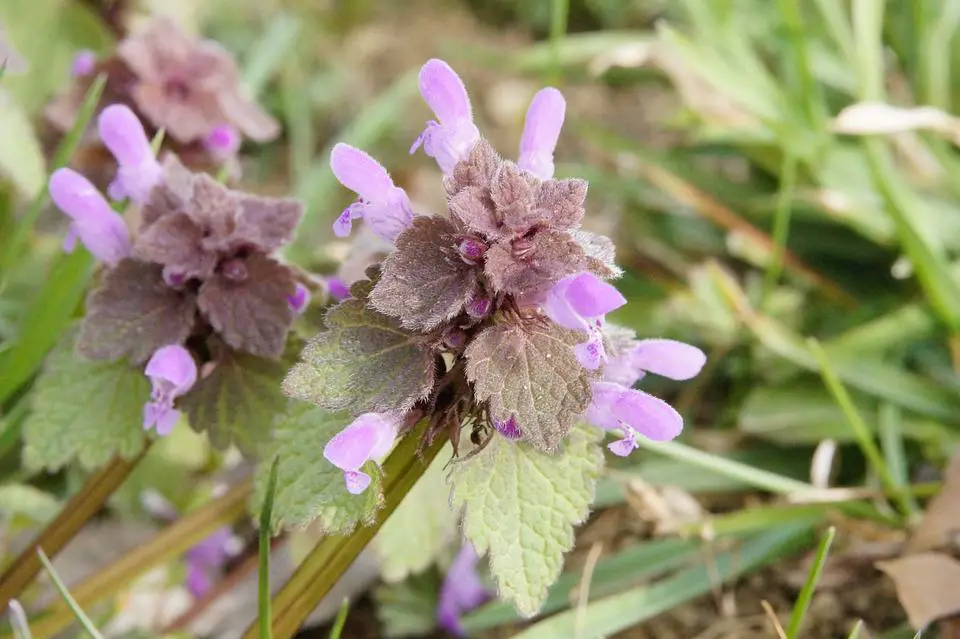
Lamium, or dead nettle, is a small perennial with a distinct appearance: square stem, silvery leaves, and purple, pink, or white flowers. It is a member of the mint family, native to temperate western Asia, Europe, and North Africa.
It’s called “deadnettle” since its leaves look like that of stinging nettles except without the sting (hence “dead”). Zones 3–8 are suitable for this herbaceous plant.
This low creeper likes to be in the shade, although it can handle some sunlight. It’s a good idea to use this plant as a groundcover in shaded places if you don’t mind it spreading rapidly to cover huge areas. It is effective in hiding deteriorating bulb foliage and choking out many weeds.
Creeping Jenny / Moneywort (Lysimachia nummularia)
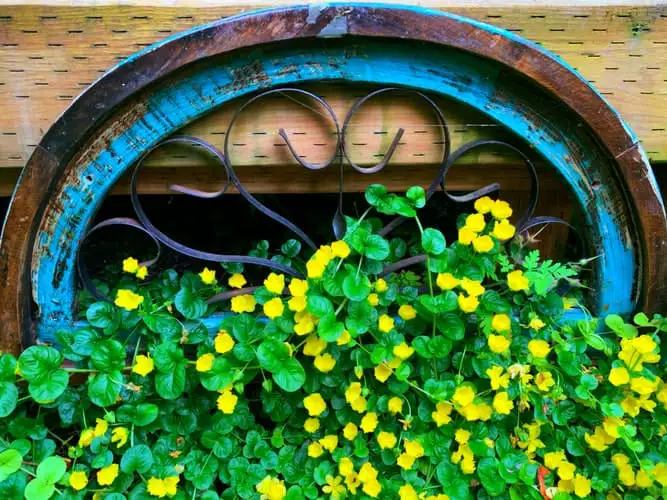
Creeping Jenny is a tough ground cover that thrives in zones 3 through 9. It likes moist environments. Although it can survive in part shade, it is best grown in full sun for the richest color.
It has round, penny-sized, shiny leaves and pretty yellow blooms on lengthy, trailing stems. Creeping Jenny rapidly occupies a broad area since it roots freely, the stems readily branch and establish mats, so it does a great job of choking out weeds.
This plant can definitely be invasive.
You can get Creeping Jenny to encircle your pond, flow down a wall, or surround a path. In mixed container gardens, it also works well as a spiller. Creeping jenny is flood tolerant, and it can survive in almost any environment: full sun, part shade, or even full shade, which will make you love it even more.
Dragon’s Blood Sedum (Sedum spurium)
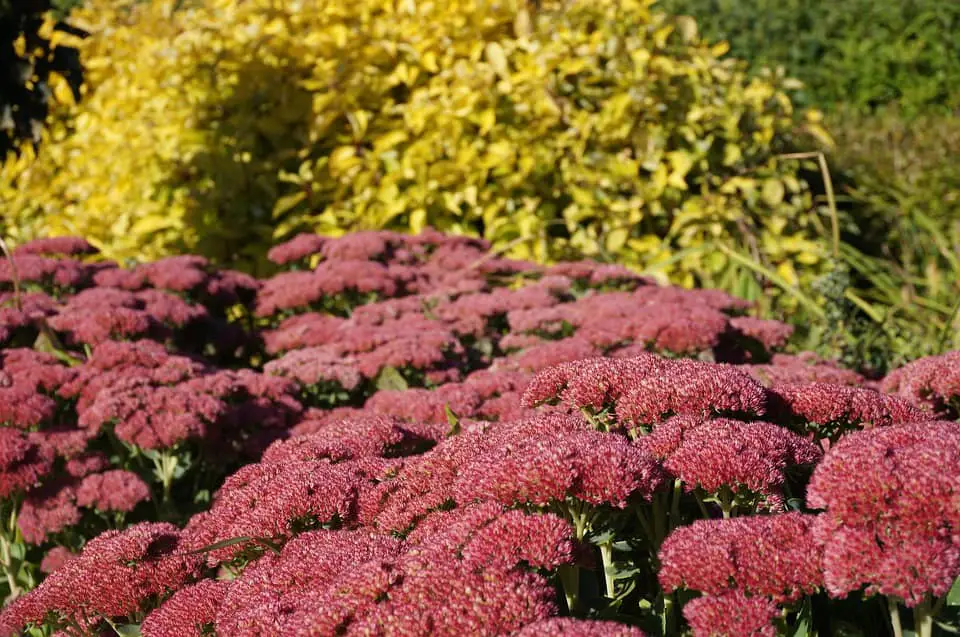
Dragon’s Blood Sedum is a trailing, succulent mat of red-outlined dark green leaves and showy pink or red flowers in the summer. Other names for the tough Sedum spurium plant are Caucasian Stonecrop, Schorbuser Blut, and Two-row Stonecrop.
Like Creeping Jenny, Dragon’s Blood Sedum spreads quickly. That’s due to its freely rooting, ropy stems. When this ground cover is healthy, happy, and sufficiently dense, it’s powerful enough to suppress weeds, but it’s not an invasive plant.
It doesn’t want to be in the shade since it can’t deal with plants that rise taller and shade the soil.
Dragon’s Blood sedum plants die down during the winter, as signified by the leaves turning maroon. But, they come back with vitality in the spring, which will show in the bright green leaves. Just the leaves at the ends of the stems are fully evergreen in most regions. As the summer progresses, fresh sprouts begin to grow, filling certain sunny parts of your landscape with poor soil.
When grown alone or in combination with other spreading sedums, Dragon’s Blood sedum occupies the spaces between paths, traces down walls, and blankets rock gardens.
Creeping Mazus (Mazus reptans)

– Mazus reptans, also referred to as “creeping mazus” or simply “mazus”, is another low-growing perennial groundcover that can suppress weeds. It grows best in partial shade but will still survive in completely shaded areas as well. It is hardy in Zones 4-9. Creeping mazus can easily develop into a closely packed, ground-hugging mat of brightly colored, green foliage with beautiful purple-blue flowers (during summer). This ground cover would be an outstanding choice in limited spaces, such as in rock gardens or in the gaps between stepping stones. Keep Mazus hydrated when it’s hot outside. The ideal soil conditions for mazus is well-draining, moist, rich soil.
Creeping Raspberry (Rubus Hayata-koidzumii or Rubus calycinoides)
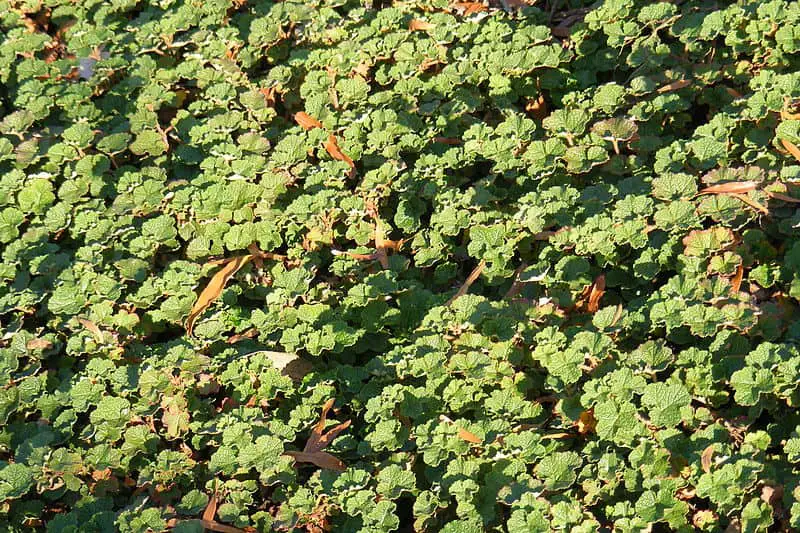
Do you want a lovely plant for your rock garden or something to replace your lawn? How about a low-maintenance ground cover?
Creeping Raspberry is a wonderful and attractive ground cover that is naturally hardy, resilient, and adaptable. It has basic requirements and is well worth cultivating in your garden.
Creeping Raspberry is a part of the Rosaceae family. It makes a dense mat of three-lobed leaves on lengthy, cane-like stems, which provide an interesting ground cover. This plant is native to Taiwan, where it thrives at high altitudes.
The creeping raspberry is a kind of evergreen plant, with the leaves having a bronzy underside and take on a rusty-looking shade in the winter. It yields white flowers in the summer, followed by eye-catching vibrant orange-colored fruits.
You may use it as a flowing decor in a hanging basket indoors, in addition to using it as a ground cover and weed-suppressant in your yard.
Dianthus
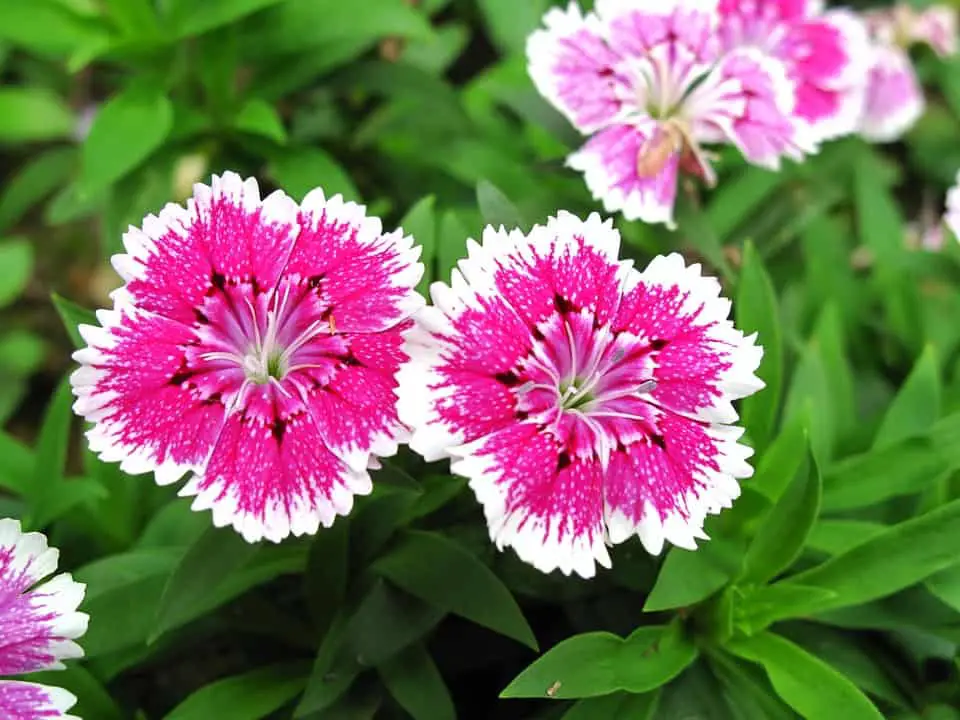
If your landscape looks a little dull and you want a splash of color, Dianthus would be a fabulous addition as a ground cover.
Dianthus plants exist in a wide range of sizes and structures, from very small variants that form a dense, compact cluster of leaves and flowers to big species that reach up to three feet tall with practically no base foliage.
Typically, Dianthus are mat-forming plants with very close leaf spreading. This hardy, cold- and drought-tolerant ground cover can withstand some salt, and deer will stay away from it.
You may use it for everything from edging, slopes, rock gardens, pathways, and patios. The main identifier of Dianthus flowers are five petals, usually with frilled edges, and are pale to rich pink (most species). There are so many wonderful species (about 300) of this flowering plant you can mix and match for your garden!
Keep in mind that these plants will flower more with more sunlight and well-draining soil. It would help if you also deadheaded to encourage beautiful fresh growth.
Red Creeping Thyme (Thymus praecox coccineus)
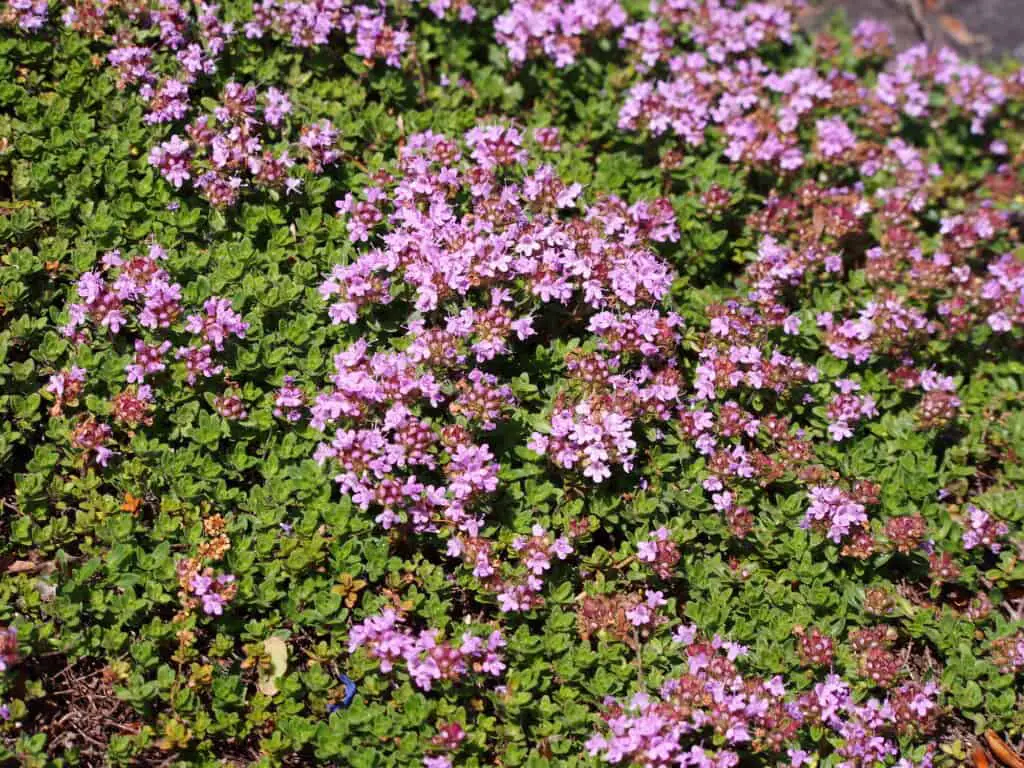
Red Creeping Thyme is a heat- and drought-tolerant ground cover that thrives in zones 3 to 9. It prefers full sunlight and grows barely two to four inches tall, making it an ideal ground cover.
It’s also deer-resistant. In spring, red creeping thyme gives beautiful, dark green color to your landscape, but it looks the best in the summer when it blooms in stunningly deep magenta-red flowers. It also attracts butterflies and repels deer. But the best part is it chokes out the weeds completely since it makes a dense, flat mat.
It’s best to plant it between stepping stones since it releases a pleasant smell when you walk on it. Plant it along wall surfaces, in edges, and other hard-to-weed spots in your landscape.
Stonecrop (Sedum)
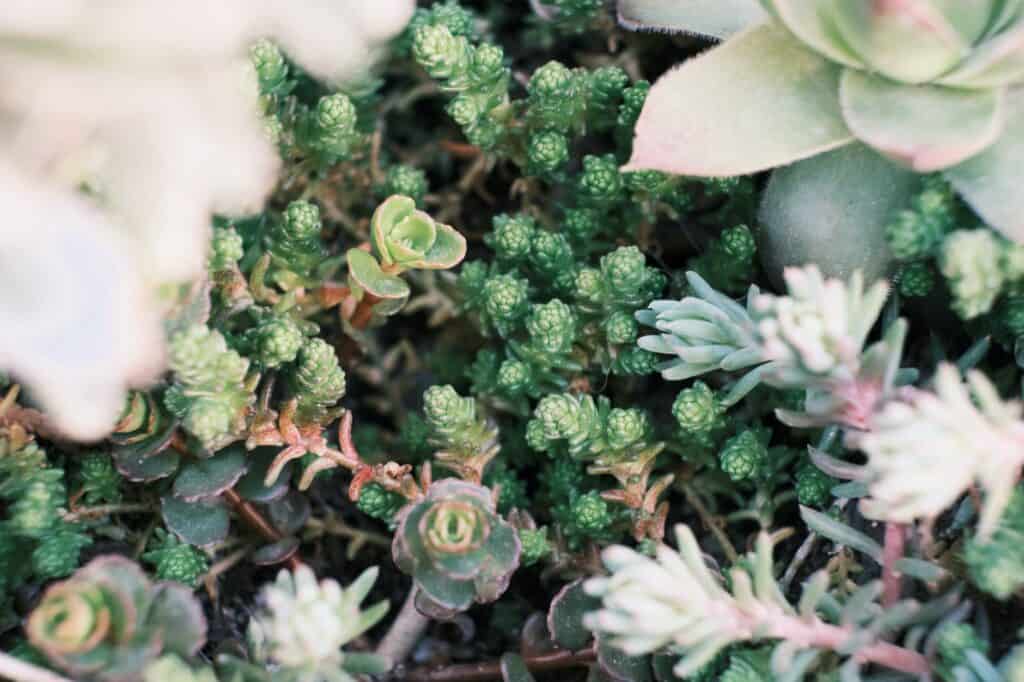
Stonecrop (also referred to as sedum or orpine) plants all have a rosette pattern, and the majority of them grow a flower that is kept over the base foliage.
The leaves are quite glossy and thick. Stonecrop makes an excellent ground cover because it’s dense, it adapts to varying temperatures, and it’s simple to care for. These plants also don’t grow very tall or quickly, so there’s no need to be concerned about them being invasive.
Also, you’ll rarely encounter pest problems with them, and they are disease-resistant. Certainly, planting a stonecrop is a great idea for a beginner gardener. They can be grown both indoors and outdoors in sunny, warm areas. The stonecrop plant is ideal for use in container gardens, rockeries, pathways, and perennial borders.
Hens and Chicks (Sempervivum tectorum)
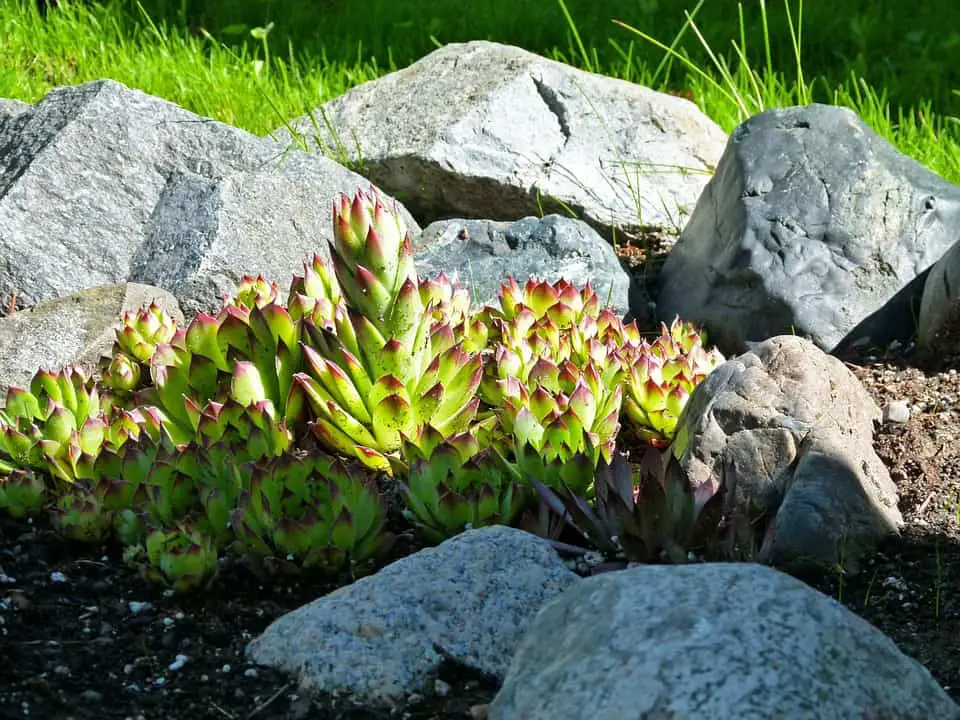
Hens and chicks plants get their name from the rosette form and the fact that they create a lot of babies.
Growing Hens and chicks in a rockery or a dry, nutritionally lacking area where other plants can’t survive is a smart idea. Sempervivum tectorum indeed has a remarkable tolerance for bad soil and harsh environments. This alpine or rock garden plant stores water in its thick and fleshy leaves; thus many gardeners like it as a ground cover for dry areas.
An underground runner connects the mother plant to the chicks (babies). Hens and Chicks make great container plants on both the inside and outside of the house.
Sempervivum comes in about forty different varieties. But even though hens and chicks come in a wide range of colors, they are most commonly seen in green, red, purple, or a mixture of these colors. The hens and chicks have a lovely, distinct look that brings variety to the garden, plus they’re hardy enough to withstand the harsh winters. Most are zone 3 hardy and can withstand temperatures as high as that of zone 9.
To keep the roots from rotting, place them in dry, well-drained sandy or gravelly soil. Did you know? Sempervivum was once placed on rooftops in Europe for various purposes, including trying to ward off lightning and fire, keeping slates in place, and supplying quick salad food in the winter.
Catmint (Nepeta mussinii)
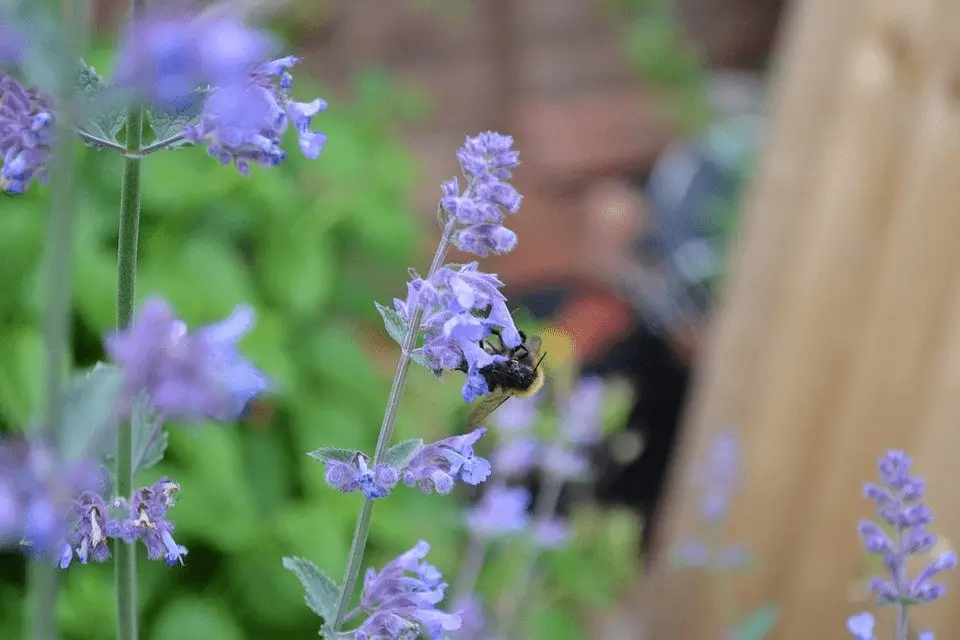
Most people are unsure about the distinction between catmint and catnip. Although they are essentially the same plant with much of the same characteristics, there are differences between the two. In the garden, catnip (Nepeta cataria) has a lower aesthetic appeal than catmint (Nepeta mussinii).
Catmint is a fragrant herb that can be found in many gardens. Among mounds of grey-green foliage, it grows clusters of lavender-blue flowers. This easy-to-grow plant has a fascinating background when it comes to its different landscape applications.
Catmint is great for edging or mass planting, and it works well as an insect deterrent near your edible crops. Catmint can live in full sun or part shade, as long as the soil is decent and well-drained. They will also tolerate heat and drought, which makes them ideal for dry gardens.
You can use fresh, frozen, or dried catmint for cooking purposes. As the flowers start to bloom, harvest the top leaves, stems, and flowers if you like. You can add its shoots and leaves to your soups!
‘Gro-Low’ sumac (Rhus aromatica ‘Gro-Low’)
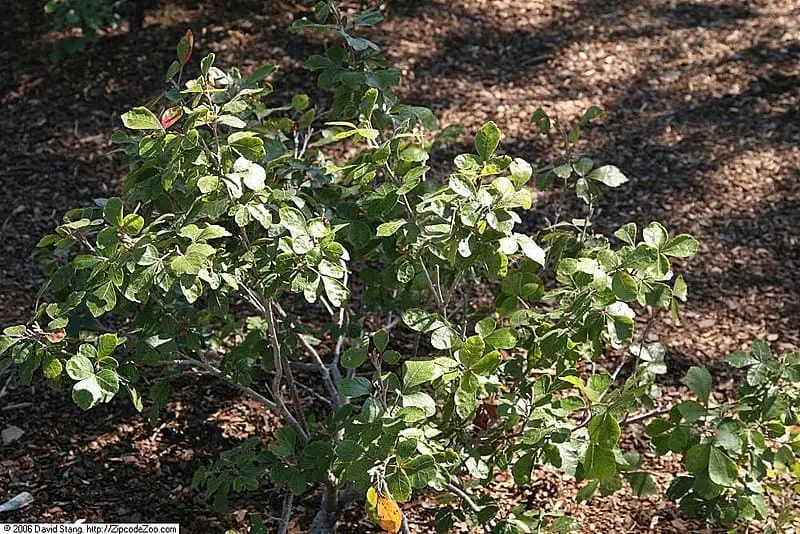
Gro-Low sumac was favored by growers for its dwarf habit, making it ideal as a ground cover. It lives in poor, dry soil and can grow in intense sunlight or heavy shade—it just needs decent drainage.
The spreading branches take root where they come into contact with the earth, which aids in forming a thick weed-controlling mat. It’s a complete autumn splendor. That alone is good enough to make it into your garden!
Plumbago (Ceratostigma plumbaginoides)

Plumbago or leadwort is a spreading plant that combines all of the best qualities of a groundcover without being unpleasant and invasive. Its name is derived from the Latin word plumbum, meaning “lead.” The herb was believed to be a treatment for lead poisoning back in the first century AD.
Although it may not be a cure for lead poisoning, it is an excellent groundcover. Plumbago is loved for its pretty blue or white flower clusters that grow from summer to fall. You’ll also love it because it’s a wiry, mat-forming perennial with rhizomes that extend to establish a beautiful ground cover.
Its mounding growth habit makes it ideal for landscape beds, particularly in the shade. Moreover, plumbago may be pruned to shape an informal hedge or used to create a beautiful formal hedge. It would finally grow to shrub size if it didn’t freeze, but winter usually prunes it to the ground, making it low-maintenance.
Greek Oregano (Origanum vulgare ssp. hirtum)
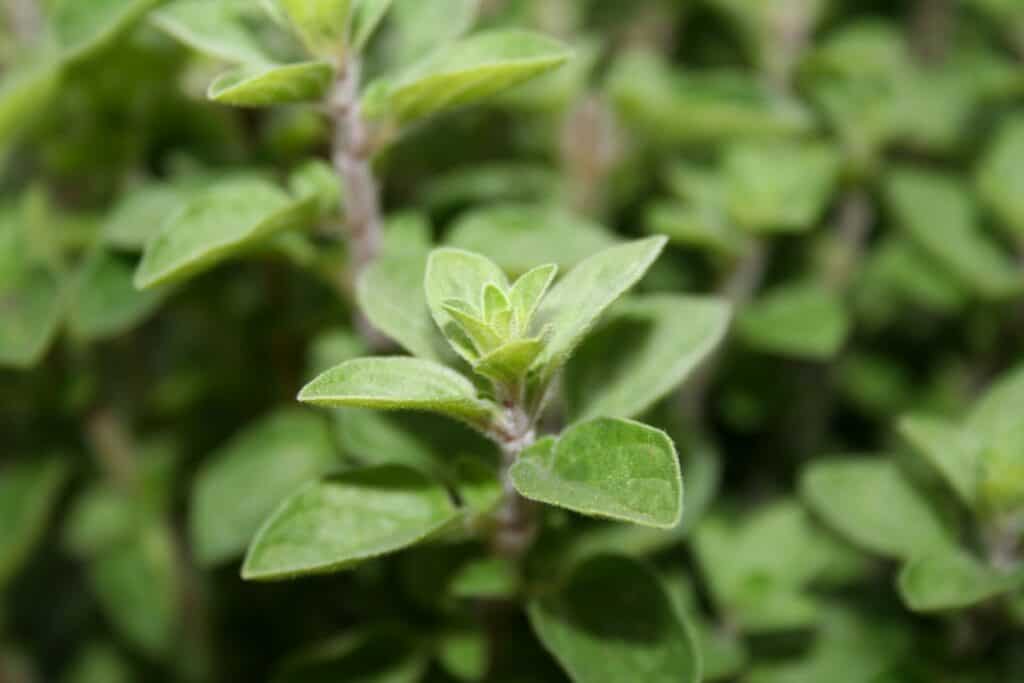
If you want to smell Italian or Greek cuisine whenever you go by a section of the garden, a Greek oregano ground cover will deliver that one-of-a-kind feeling. Groundcover oregano has that scent when crushed or stepped on that sends you longing for delicious Mediterranean food.
Aside from its smell, its positives are: it needs very little care, prevents weeds, looks wonderful, draws in insects, thrives in hot and dry areas, and keeps in moisture. It would help if you did some things to force ground cover oregano into staying that way because it is a naturally tall herb. Start when the plants are young: nip them back to within two inches from the ground. The plant will be encouraged to grow outward instead of upward as a result of this. Plants will eventually blend to form a Greek oregano groundcover.
To keep this up, give it a limited supply of water and cut off some height a couple of times (or even once) in its growing season. You’ll only need to care for your Greek oregano just a few times a year after it’s established. And, if you want to use oregano for cooking, harvest whenever the stems start to grow tall and are about to flower. This is when the leaves are full of their amazing essence and flavor.
One last thing: according to some test-tube studies, oregano and oregano oil are rich in antioxidants. If this isn’t a good enough reason to add it to your landscape (aside from keeping away weeds), I don’t know what is.
Lamb’s Ears (Stachys byzantina)
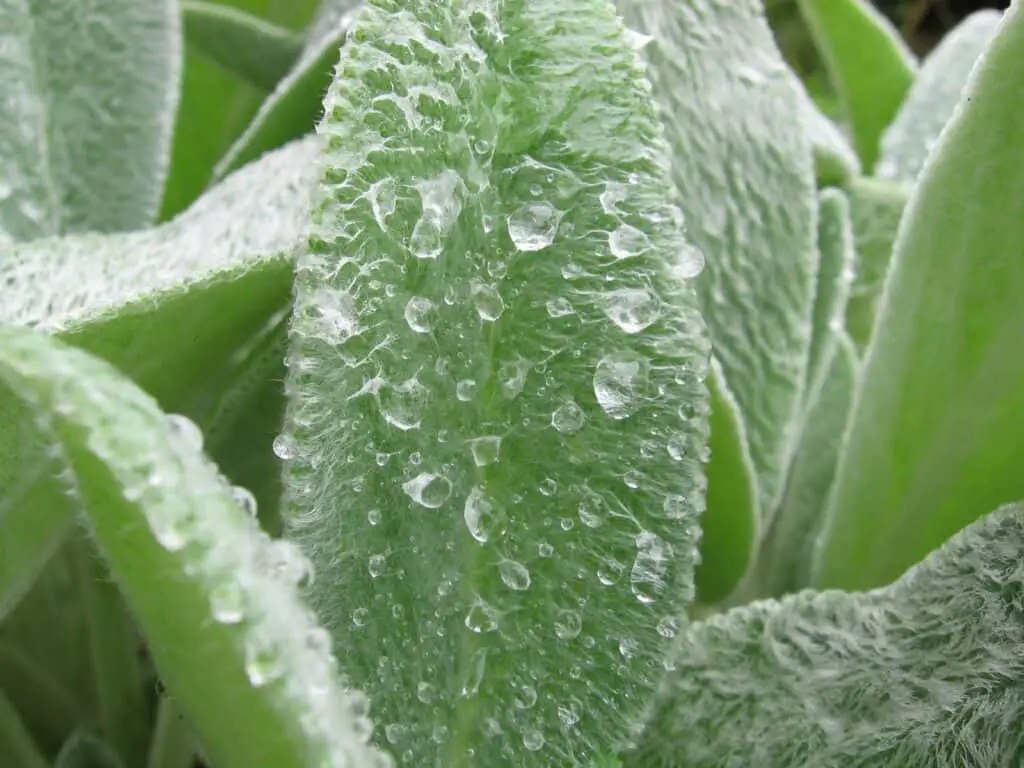
The ground cover of Stachys byzantina is fantastic for weed control. It’s a thick, low-growing herb that can quickly spread in a garden bed if given the proper care, so it’s ideal for filling in gaps in your borders and keeping weeds away. And because it’s a low-growing plant, you can plant lamb’s ears on the garden border.
The wooly feel and velvety soft texture of Lamb’s Ears’ leaves will appeal to children. Aside from the leaf shape’s resemblance to a lamb’s ear, the color is silvery grey to a faint green. The plant is a perennial evergreen, although it can die back and look worn out throughout the winter months, and it will regrow in spring.
Lamb’s ears can withstand chilly temperatures in zones 4 through 8. Unless you have lots of midday shade in your yard, extreme heat in the warmer areas can make growing it a problem.
FAQs
When will the ground covers start to choke out weeds?
Ground covers will take up to a couple of years to completely establish and become dense enough to choke out most undesirable weeds, according to the Colorado State University Cooperative Extension. It will take a little bit longer for higher altitudes.
You should remove whatever weeds that emerge as soon as possible. To minimize massive damage, do not spray herbicides on your ground cover.
Can a weed-suppressing ground cover take the place of my lawn?
You can use any of these ground cover plants as a lawn replacement, as long as you meet the plant’s soil and sunlight (or shade) requirements. Any of these weed suppressing plants, especially those that don’t require lots of water, would be better than a lawn when it comes to upkeep.
REFERENCES
https://www.rhs.org.uk/plants/pdfs/agm-lists/agm-ornamentals.pdf
https://ucanr.edu/sites/poisonous_safe_plants/Toxic_Plants_by_common_Name_659/
https://csuvth.colostate.edu/poisonous_plants/Plants/Details/123
https://hgic.clemson.edu/factsheet/phlox/
https://www.biodiversitylibrary.org/page/470454#page/155/mode/1up
www.missouribotanicalgarden.org/PlantFinder/PlantFinderDetails.aspx?taxonid=285438
https://www.jstor.org/stable/1930514?seq=1
https://www.calrecycle.ca.gov/organics/xeriscaping
https://scholarworks.montana.edu/xmlui/handle/1/5708
https://pfaf.org/user/Plant.aspx?LatinName=Artemisia+schmidtiana
www.theplantlist.org/tpl1.1/record/kew-205442
https://hort.extension.wisc.edu/articles/spotted-deadnettle-lamium-maculatum/
https://www.uaex.edu/yard-garden/resource-library/plant-week/moneywort-6-24-05.aspx
www.illinoiswildflowers.info/weeds/plants/moneywort.htm
https://www.fs.fed.us/database/feis/plants/forb/lysnum/all.html
https://www.uaex.edu/yard-garden/resource-library/plant-week/dragonsblood-sedum-9-12-08.aspx
https://www.missouribotanicalgarden.org/PlantFinder/PlantFinderDetails.aspx?kempercode=e190
https://archive.org/details/perennialgroundc0000mack/page/n9/mode/2up
https://www.newworldencyclopedia.org/entry/Carnation
https://extension.psu.edu/to-deadhead-or-not-your-final-answer-is
http://www.missouribotanicalgarden.org/PlantFinder/PlantFinderDetails.aspx?taxonid=254207
https://www.britannica.com/plant/sedum
www.missouribotanicalgarden.org/PlantFinder/PlantFinderDetails.aspx?kempercode=b711
https://advances.sciencemag.org/content/6/20/eaba0721
https://piedmontmastergardeners.org/article/plumbago-a-true-blue-accent-in-the-sunny-border/
www.missouribotanicalgarden.org/PlantFinder/PlantFinderDetails.aspx?taxonid=285165
https://pubmed.ncbi.nlm.nih.gov/8933203/
https://pubmed.ncbi.nlm.nih.gov/24629960/

